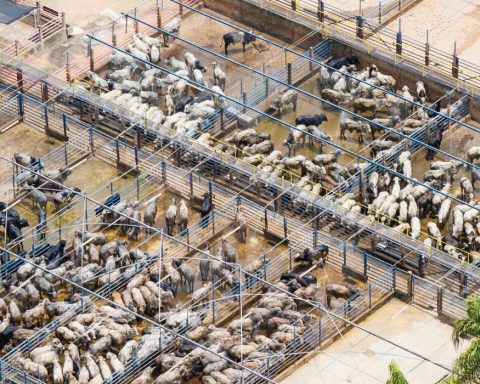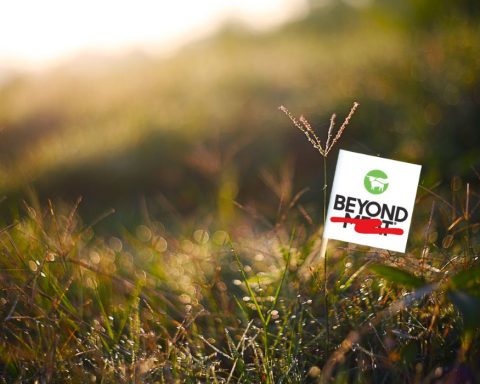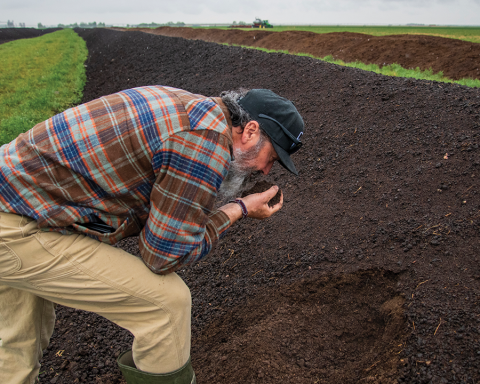Utterly unperturbed, Lili Ana Rodrigues gently pries open the roof of a hand-made wooden bee box and slices off paper-thin peaks of charcoal-coloured parchment that look like miniature mountains. She then carefully inserts a plastic syringe into what should be the dangerous, inner domain of several hundred wild bees.
The inner hive is in fact pulsating with tiny yellow-and-black Melipona bees. Humming squadrons quickly take formation to alight on her hand and hair. As nectar is drawn up into her chef’s syringe, then dabbled onto a spoon for strangers to taste, more Meliponas arrive and seem poised to attack the invaders. But instead, the stingerless bees merely tickle as they crawl across human arms and eyebrows, apparently foraging for some new exotic blossom to savour and pollinate. No doubt they are dismayed to taste only salty sweat, since they lose interest and quickly disappear.
By contrast, the amber gold nectar they produce glides across the palate like liquid silk. More fluid than honey made from domestic bees, it transmits a translucent sparkle and has a unique lemony finish and a tart hint of acidity to temper the natural sugar. Only a single drop is needed to trigger a delighted grin.
Nobody knows that better than Richardson Frazao, a Brazilian biologist who has become a leading scientific authority on the wild bees of the Amazon. He is also the field manager of an innovative program to protect the Meliponas and the biodiverse habitat they both depend on and sustain.
Rodrigues’s 70 wild bee boxes, built in a grove of tropical fruit and nut trees some 200 kilometres from the equatorial port of Belem, Brazil, serve as the most successful pilot project among a dozen poor, remote communities in the eastern Amazon. Each hive produces about one litre per year, which Rodrigues bottles and sells as nectar. She also uses the wax-like propolis to make distinctly scented soap, shampoo and cosmetic products.
The annual income this generates for her family is modest by Brazilian standards, and meagre by North American or European standards. But in a region ravaged by high unemployment, such self-generated income is a domestic godsend.
More strategically, Rodrigues’s income from wild nectar husbandry is higher – and more sustainable – than the only alternative: being paid low wages to slash, burn and raze tropical forests for lumber and cattle interests. To date, some 70 million hectares have already fallen in Amazonia, and her small land holding is on the northern front of approaching clear-cuts.
The bulwark against this, Frazao has calculated, will be rural communities that replicate Rodrigues’s example and discover that they can earn higher, more enduring incomes by protecting their forests rather than being temporarily hired to help destroy them.
His daring plan has the backing of the Peabiru Institute (a science-oriented foundation based in Belem), the Netherlands’ Royal Tropical Institute, Conservation International and The Nature Conservancy. All agree that Frazao’s wild bee initiative may be the most effective way to protect remaining Amazon forests, restore biodiversity and promote economic equity among some of Brazil’s poorest peoples.
That is a lot of weight to rest on the delicate wings of an insect barely bigger than a fingernail. But the saving grace is that there are billions of them, in hundreds of species, each of which has been selected through evolution to pollinate distinct trees, flowers and shrubs. That means they are the lynchpin of biodiversity.
In the densest parts of still-intact Amazonia forests, Frazao has recorded up to 79 species of Melipona bees in a single hectare. This confirms a jaw-dropping level of indigenous forest biodiversity there, but it is by no means an isolated example.
Of the 20,000 wild bee species globally, there are some 400 known species of Melipona bees in the Amazon basin, which extends into Peru, Bolivia and Ecuador. About 10 new species are discovered each year. Frazao himself may soon be credited with one if independent tests verify his discovery.
Shy with strangers, but quick to flash a genial smile – especially within tasting distance of Melipona nectar – Frazao hopes to maximize community bee projects by combining science and social engagement.
“I get lots of pleasure from identifying wild bees, and from doing pure science,” the PhD candidate says during a translated interview in his Peabiru Institute office. “But science is only part of the solution. The other part is to show communities the real value of biodiversity, and to empower them to protect it.”
To that end, since 2006, Peabiru and global foundations have helped finance more than 2,000 bee box placements with 350 families in 16 remote communities. There, typical cash incomes average less than $3 per day. The recipients include indigenous tribes, Afro-Brazilian slave descendants called Quilombolas, and the rural poor.
In each setting, Frazao looks for entrepreneurial champions, like Rodrigues, to ignite community interest with bottom-line economics. A typical bee box costs $25 to make with local labour and materials, but yields nectar worth up to $90 each production season. The bee pollination also increases the nearby yields of edible fruits and nuts, which can be harvested for subsistence food or sold for cash.
As with domestic bees, Melipona hives can be split and transplanted to new bee boxes, which in turn can be divided again. So, in the manner of bank bonds paying compound interest, Frazao and Peabiru Institute hope to soon see their original investments (jointly shared by Peabiru and community associations) accelerate in scale and value.
They have plans to enlist Brazil’s network of embassies and globally famous chefs to promote the “Amazon Amber” Melipona nectar; sell the scented soap and cosmetics under special labels; and scale up production by using solar-powered extractors where power grids don’t exist. Long-range goals include a portable, commercial-grade honey processing unit, which also refrigerates the nectar so it does not crystallize or ferment before it can reach outside markets.
However, Frazao cautions, the health of the wild bees and the forests they sustain will remain the highest priority. Their plan includes carefully confining each Melipona species to its endemic location, not mixing species in adjacent bee boxes or districts, and resolving not to torque production beyond the natural limits defined by evolution.
“As more poor communities join in wild nectar production, they will fight to protect and even begin restoring native tropical forests,” predicts Joao Meirelles, a noted Amazon scholar, author and founder of Peabiru. “The numbers are on our side. Every hectare saved can support 50 to 80 Melipona species, and up to 500 bee boxes with a foraging range of 600 hectares.”
Frazao nods, adding: “My dream is that these Amazon communities can position themselves in a market where they are paid proper value for their work and unique, high-quality product, while at the same time protecting their forest and biodiversity.”
And does the scientist who works with bees all day dream of otherworldly Melipona nectar at night? A surprised, faintly guilty grin telegraphs his answer.







